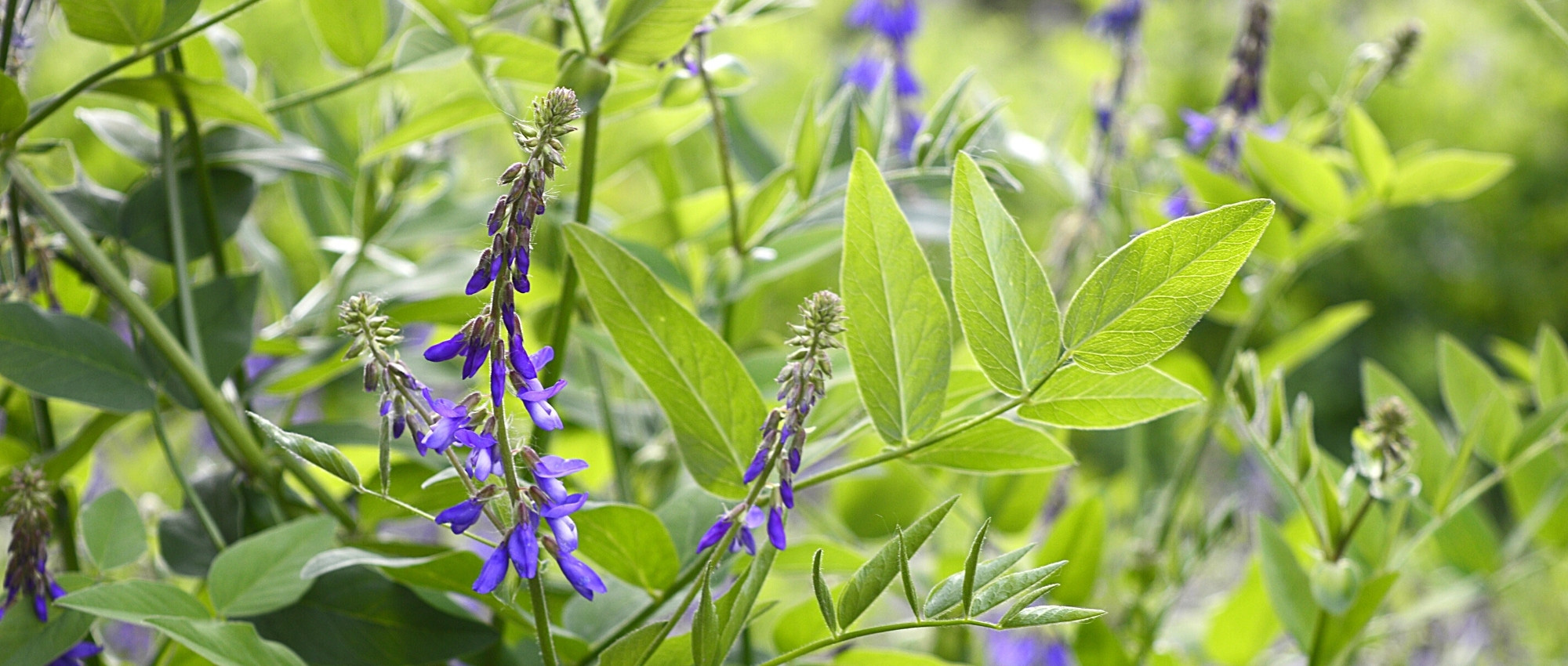
Galega: planting, growing, and care
Contents
Galega in a few words
- Galega is a vigorous perennial with the charm of a wildflower!
- In spring or summer, it produces clusters of blue, mauve, pink, or white flowers, resembling pea blossoms.
- It boasts finely divided foliage, ranging from soft green to bluish.
- Galega thrives in full sun or partial shade, in fresh and rich soil.
- This easy-going perennial grows quickly, is hardy, and resistant to diseases.
- It is perfect for cottage-style or naturalistic gardens.
The word from our expert
Goat’s Rue is a very vigorous, tall perennial, with all the charm of wild plants! It produces in spring or summer clusters of pea-like flowers, in blue, mauve, or white, depending on the variety. Its superb foliage, finely divided into leaflets of tender green or bluish hues, is also highly appreciated. Goat’s Rue grows between 80 cm and 1.50 m tall, with flexible stems that sometimes tend to spread.
Goat’s Rue thrives in sunny spots (or partial shade in southern France) and grows in any ordinary soil, though it prefers fresh, rich, and humus-bearing soils. A hardy, robust, and low-maintenance perennial, Goat’s Rue requires little care… except for controlling its growth to prevent it from overwhelming neighbouring plants or spreading too vigorously in the garden. Therefore, it’s best to cut the plant back just after flowering.
With its wildflower-like appearance, it’s an ideal plant for naturalistic gardens! It pairs beautifully with knautias, scabious, burnets, penstemons, cornflowers, poppies, and ornamental grasses. Its delicate flowers also fit perfectly into romantic gardens, cottage gardens, and colourful mixed borders.
Discover all our tips for successfully growing Goat’s Rue in this guide!
Botany
Botanical data
- Latin name Galega officinalis
- Family Fabaceae
- Common name Goat's Rue, French Lilac, Spanish Sainfoin, Lavanèse, False Indigo, Spanish Lilac…
- Flowering spring (May-June) or summer (June-August)
- Height 80 cm to 1.50 m
- Exposure sun or partial shade
- Soil type moist, rich
- Hardiness -20 to -25 °C
Galega comprises 5 species of tall herbaceous perennials, native to Europe, Western Asia, and tropical Africa. In France, Galega officinalis grows wild, mainly in ditches, meadows, and riverbanks. Galega has been widely disseminated by humans, who cultivated it as fodder (G. orientalis) or green manure. Galega officinalis is also used for its medicinal properties. It has naturalised in North America, where it is now considered invasive.
The name Galega comes from the Latin Gala, meaning milk, and ega: “to bring, provoke”; because Galega officinalis promotes lactation. Thus, goats that consume this plant produce more milk, which is why it is called Goat’s Rue or Rue des chèvres (however, during flowering and fruiting, the aerial parts of Galega are toxic to animals). The species name officinalis is a common name for plants with medicinal properties. Examples include Salvia officinalis, common sage; Melissa officinalis, lemon balm; Hyssopus officinalis, hyssop; Valeriana officinalis, valerian… Galega also bears a variety of common names: it is called Goat’s Rue, French Lilac, Spanish Sainfoin, Lavanèse, False Indigo, Spanish Lilac, Galega officinal…

Galega officinalis: Botanical illustration
Galega belongs to the pea and bean family: the Fabaceae, formerly known as Leguminosae, which includes many plants used for human and animal food. Among the ornamental plants in this family are lupins, vetches, sweet peas, wisteria, mimosa, and the Judas tree (Cercis).
Galega is a tall perennial with a bushy habit, very vigorous and fast-growing. It reaches between 80 cm and 1.50 m in height and forms upright, branched stems with a loose and untidy habit. It may need staking to improve its structure and pruning to keep it in check. With its free and airy habit, it is perfect for cottage and naturalistic gardens!
Galegas flower in spring or summer. Galega orientalis is early, flowering from May to June, while Galega officinalis takes over and flowers throughout the summer, from June to August-September.
Galegas then form upright clusters, inserted in the leaf axils (axillary), and borne on long peduncles. They are composed of papilionaceous flowers, 1 to 2 cm long, resembling pea flowers and typical of the Fabaceae family. They consist of five petals: the upper petal forms the banner, the two lateral petals form the wings, and the two lower petals form the keel, which surrounds and protects the 10 stamens and the pistil. Galega flowers have soft hues: usually blue, mauve, pink, or white, they can also be bicoloured. They have a light fragrance reminiscent of vanilla or coconut.
Feel free to use Galega flowers in bouquets. They add a charming rustic touch, for example alongside more classic flowers like roses or lilies. Moreover, picking the flowers prevents the plant from self-seeding.
Galega flowers are melliferous and highly attractive to bees. They draw in pollinating insects, making Galegas a great addition to orchards to promote good pollination.
In addition to its flowering, Galega has very attractive foliage. The leaves, 8 to 20 cm long, are beautifully divided into narrow, elongated leaflets. They are pinnate: the leaflets, arranged on either side of the central axis, resemble a feather. They have a lovely soft green or bluish colour. The leaves are arranged alternately on the stems (one after the other).
Galega is a deciduous plant; its aerial parts (stems and leaves) dry out in autumn and regrow in spring.

The flowering of Galega officinalis, Galega hartlandii ‘Alba’ (photo W. Erhardt), and Galega hartlandii ‘Lady Wilson’
As a member of the Fabaceae family, Galega naturally enriches the soil with nitrogen, which is why it has sometimes been cultivated as green manure, alongside vetch, alfalfa, or phacelia. The roots of Galega (and other Fabaceae) have nodules housing bacteria of the genus Rhizobium. The bacteria fix nitrogen from the air and supply it to the plant. Thus, Fabaceae do not need nitrogen fertilisers, and their cultivation helps enrich the soil with nitrogen.
After flowering, Galega produces pods (like peas and beans), 2 to 3 cm long, containing the seeds. When conditions are favourable, Galega tends to self-seed and naturalise. Prune the plant after flowering to prevent seed production if you want to avoid it spreading in the garden.
Galega officinalis is renowned for its medicinal properties. Due to its richness in galegine, it is said to have hypoglycaemic properties, lowering blood sugar levels, which led to its use in treating diabetes. It is also considered diuretic, galactagogue, and was once used to treat the plague. Taken as an infusion, it is believed to promote lactation in breastfeeding women.
Warning: during flowering and fruiting, the aerial parts of Galega officinalis are toxic to animals, especially sheep. Since Galega grows wild in France and is sometimes found in meadows, there have been cases of livestock poisoning from hay containing Galega. As a fodder plant, it is mainly Galega orientalis that is cultivated, as it lacks toxic substances.

The foliage of Galega officinalis
The main varieties of Galega
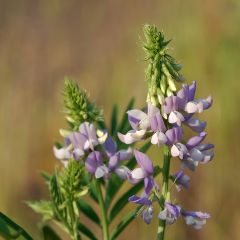
Galega officinalis
- Flowering time July to September
- Height at maturity 1,20 m
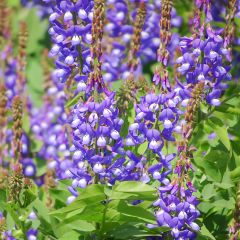
Galega orientalis
- Flowering time June to September
- Height at maturity 1,50 m
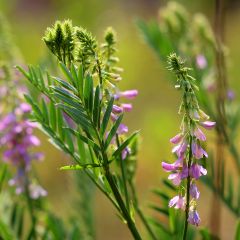
Galega hartlandii Lady Wilson
- Flowering time June, July
- Height at maturity 80 cm

Galega hartlandii Duchess of Bedford
- Flowering time July to October
- Height at maturity 1,20 m
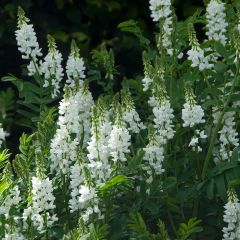
Galega hartlandii Alba
- Flowering time June, July
- Height at maturity 1,50 m
Discover other Galega
View all →Available in 1 sizes
Available in 1 sizes
Available in 1 sizes
Available in 0 sizes
Available in 1 sizes
Available in 1 sizes
Planting
Where to Plant?
Galega is a plant that thrives in open spaces, enjoying full sun while keeping its roots cool. However, in the south of France, you can plant it in partial shade to protect it from scorching sunlight. This is not a fussy or demanding plant: it grows effortlessly in ordinary soil, as long as it remains relatively cool, or even moist. It does, however, prefer light, rich, and humus-bearing soils.
Being very vigorous and prone to spreading, it is particularly suited to fallow land, slopes, and large open spaces, such as meadows, or wilder areas of the garden where intervention is minimal. It can also adorn the base of bushes and climbing plants. It pairs beautifully with the romantic flowering of roses!
When to Plant?
Planting Galega is best done in spring, around April, or in autumn (September-October). For species and varieties with spring flowering, autumn planting is preferable. In all cases, avoid periods of frost or extreme heat.
How to Plant?
You can plant several young plants together, but ensure at least 60 cm of space between them.
- Start by placing the root ball in a basin filled with water to rehydrate it.
- Dig a planting hole, two to three times the size of the root ball.
- Mix some well-decomposed compost into the soil.
- Plant the Galega in the centre of the hole.
- Fill the hole by replacing the soil around it, then lightly firm it down.
- Water generously.
- You can add a layer of organic mulch on the soil surface around the young plant to keep the soil cool for longer.
- Continue watering in the weeks following planting.

Galega officinalis (photo Franz Xaver)
Maintenance
When planted in suitable conditions (sun or partial shade, moist soil), the Galega is a very easy-going plant, vigorous and self-sufficient. Maintenance mainly involves monitoring and controlling its growth if necessary, to prevent it from overwhelming neighbouring plants. Therefore, we recommend cutting back faded flowers or severely pruning the plant just after flowering (cutting back to 20-30 cm from the soil), to prevent it from self-seeding. Additionally, pruning after flowering can encourage the Galega to produce new flowers.
If your soil tends to dry out in summer, water it occasionally to keep the soil moist. You can also apply a layer of organic mulch (straw, dead leaves, wood chips, etc.) to the soil to retain moisture for longer.
During its growth, the Galega may benefit from staking and pruning: this helps its flexible stems maintain structure while guiding them.
Robust, vigorous, and very hardy, the Galega is also rarely affected by diseases or parasites. However, its leaves may occasionally be nibbled by vine weevils.
Multiplication
The Galega can be propagated by sowing or by dividing clumps. It may also self-seed spontaneously in the garden.
Sowing
After flowering, the Galega produces pods containing the seeds. You can harvest them when they are ripe, in late summer.
Sowing is done in spring.
- Soak the seeds in water overnight before sowing.
- Prepare pots with special sowing compost. Level the surface and lightly firm it down.
- Sow the seeds by placing them on the surface.
- Cover them with compost (about 1 cm thick).
- Water gently with a fine spray.
- Place the pots under a cold frame.
It is also possible to sow the seeds directly in the ground.
Dividing Clumps
You can divide the Galega every two to three years, in late winter – early spring (March-April), or in autumn, around October.
- Dig up a Galega plant, making sure to dig wide enough.
- Remove the root ball from the soil, shaking off excess soil if necessary to better see the roots.
- Divide the plant into several sections, ensuring each has roots and buds.
- Replant immediately, either in pots or directly in the ground.
- Water generously.
Association
With its wild and untamed appearance, the Galega seems destined for cottage-style or naturalistic gardens! Pair it with other wildflowers, such as knautias, poppies, and cornflowers, in a garden area on the periphery, where you’ll let it evolve in a relatively wild and natural way, with minimal maintenance. Opt for plants with a relaxed habit, featuring flowers borne on long stems, which create a light and airy effect. Consider, for example, gaura, penstemons, hastate vervain, cosmos, yarrows, burnets… You can also include daisies, Leucanthemum vulgare. Finally, don’t forget ornamental grasses, essential in this garden style! Their floral spikes and fine leaves, swaying in the wind, add lightness and a natural sense of movement.
Discover our advice sheet “10 Iconic Perennial Plants for Naturalistic Gardens”.
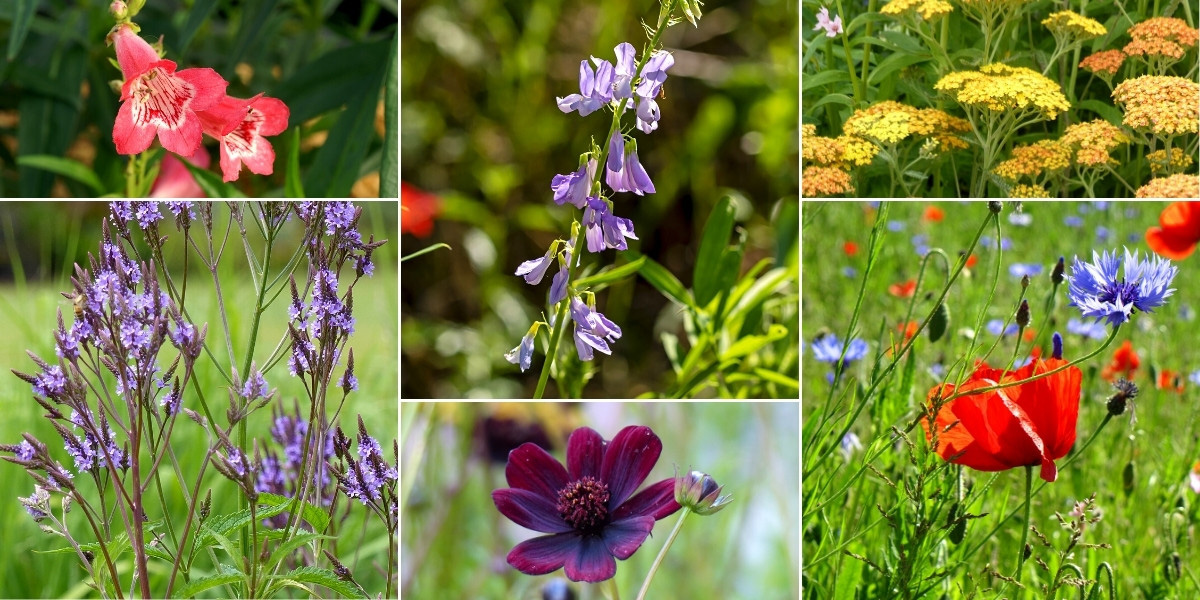
Penstemon ‘Souvenir d’Adrien Régnier’, Galega officinalis, Achillea ‘Terracotta’, Verbena hastata, Cosmos atrosanguineus, Poppy and cornflower
Galega will also find its place in a cottage garden. Ideal for enhancing old stone houses, this garden style is characterised by lush, irregularly shaped beds, combining a diversity of flowers and opulent foliage, sometimes paired with aromatic herbs, vegetables, and a few fruit trees. The flowering hues are soft: white, blue, pale pink, mauve, apricot, cream yellow… For example, integrate Galega orientalis alongside oriental poppies, German iris, Alliums, and hardy geraniums. Also discover Phlox divaricata ‘White Perfume’. Alongside them, include plants with generous foliage, such as hostas and ferns, Cynara cardunculus, artemisias…
With its soft-hued flowering, it will also be perfect for creating a romantic garden atmosphere, alongside roses, peonies, deutzias, and weigelas. Also consider the beautifully fragrant carnations from the Dianthus plumarius ‘Scent First’ series. Add a few plants with silver foliage, such as Artemisia ‘Silver Brocade’ and Stachys byzantina.
Discover our dedicated inspiration pages “Cottage Garden” and “Romantic Ambience”.
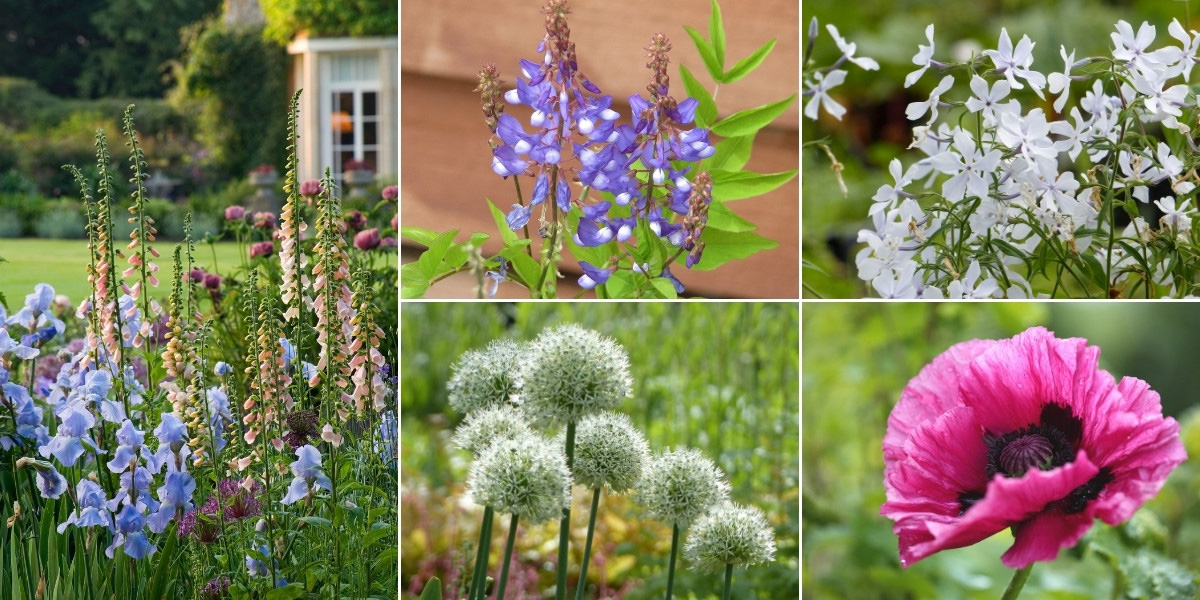
Scene featuring Iris ‘Jane Phillips’, Digitalis ‘Suttons Apricot’, and Papaver orientale ‘Patty’s Plum’ (photo MAP – The Old Rectory, Haselbech), Galega orientalis (photo peganum), Phlox divaricata ‘White Perfume’, Allium stipitatum ‘Mount Everest’, and Papaver orientale ‘Patty’s Plum’ (photo Alexandre Dulaunoy)
Galega can also fit into a more conventional bed, alongside colourful perennials and bulbs. For example, plant Galega officinalis among dahlias, lilies, crocosmias, daylilies, yarrows, and coneflowers. It will add lightness alongside these vibrant-hued flowers! Don’t hesitate to play with colour contrasts, pairing the blue flowers of Galega orientalis with the orange blooms of avens ‘Totally Tangerine’, Hemerocallis fulva, Trollius asiaticus, and oriental poppy ‘Harvest Moon’. Indeed, blue and orange are complementary colours: they are opposite on the colour wheel, and pairing them creates a stunning contrast and depth, as they enhance each other!
→ Discover more ideas for pairing Galega in our advice sheet!
Useful resources
- Discover our range of Galega
- To associate Galega, feel free to explore our inspiration page “Naturalistic Garden” as well as our advice in “10 emblematic perennial plants for naturalistic gardens”
- Subscribe!
- Contents

































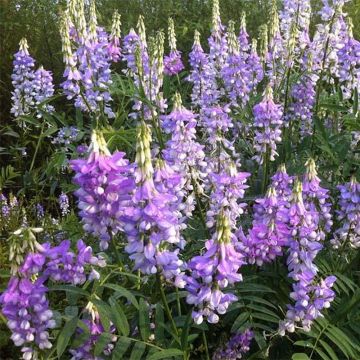
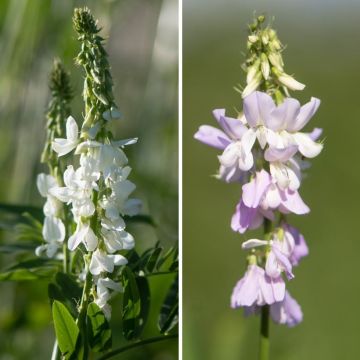


Comments